SOHIB ABD ALRAHMAN MOUHSIN NASER1
ISTANBUL AYDIN UNİVERSİTY
Email: Sohibalharthy@gmail.com
HNSJ, 2021, 2(10); https://doi.org/10.53796/hnsj21010
Published at 01/10/2021 Accepted at 16/09/2021
Abstract
In this study, going to discuss many topics that are important to consider, including online branding, which is considered one of the most important tactics used in our present time to reach customers, which is attracting the customer’s interest through online communication tools, this study adopted on the Toyota Motor Company and its Japanese online branding, which used to produce textiles but now it’s one from the largest car companies in the world. The importance of this study lies in discussing the importance of Toyota’s strategy in its online branding through the digital and electronic brand, social media to achieve the goals of Toyota online branding by reaching many customers as possible and communicating with them, this study will analyze the Toyota’s brand, by using the brand resonance pyramid and SWOT analyze methods.
Key Words: branding, branding strategy, Digital branding, branding loyalty, branding equity, branding extension.
عنوان البحث
استراتيجيات العلامات التجارية عبر الإنترنت لتويوتا
صهيب عبد الرحمن محسن ناصر1
1 جامعة اسطنبول أيدين
البريد الإلكتروني: Sohibalharthy@gmail.com
HNSJ, 2021, 2(10); https://doi.org/10.53796/hnsj21010
تاريخ النشر: 01/10/2021م تاريخ القبول: 16/09/2021م
المستخلص
تناقش هذه الدراسة العديد من الموضوعات المهمة التي يجب مراعاتها ، بما في ذلك العلامات التجارية عبر الإنترنت ، والتي تعتبر من أهم الأساليب المستخدمة في عصرنا الحالي للوصول إلى العميل المستهدف ، والتي تجذب اهتمام العميل من خلال أدوات الاتصال عبر الإنترنت ، وهذه الدراسة المعتمد على شركة تويوتا TOYOTAوعلامتها التجارية اليابانية على الإنترنت ، والتي كانت تستخدم في إنتاج المنسوجات ولكنها الآن واحدة من أكبر شركات السيارات في العالم. تكمن أهمية هذه الدراسة في مناقشة أهمية إستراتيجية Toyota في علامتها التجارية عبر الإنترنت من خلال العلامة التجارية الرقمية والإلكترونية ووسائل التواصل الاجتماعي لتحقيق أهداف علامة Toyota التجارية عبر الإنترنت من خلال الوصول إلى العديد من العملاء والتواصل معهم ، وستقوم هذه الدراسة بتحليل علامة تويوتا التجارية باستخدام طرق تحليل هرم الرنين و .SWOT
- Introduction:
After manufacturing textiles and yarn in 1918, by Toyota owner and inventor of the first automatic handle for Sakish Toyota, when Sun Kushiro Toyota devoted time to producing cars, but in 1923 an earthquake destroyed many Japanese railways, making cars an essential transportation method (Teich, 2013). Then the Japanese government encouraged the productions of vehicles for both domestic and commercial purposes, giving the automakers help in recognizing the brand and some of the noble goals to work for. In 1929, Toyota has sold the production and sales rights to a British company; “Platt Brothers” for 10,000 pounds, In 1937, Toyota Motor Corporation was incorporated as an independent company, which has seen dangerous growth after WWII (Saxonhouse, 2010).
Although Toyota is Japanese, it has proven to be a global and the most famous product in the world. Through its brand which has R&D centers all over the world, now it is a leader in the field of hybrid electric vehicles and its brand has great sales in all markets (Wada, 2004). In 2017, Toyota was the largest in the world by manufacturing more than 10 million cars yearly, with over 300,000 employees in its arms around the world. Toyota ranked first in the world as the best car company in the annual “Most Liked” ranking for the “Fortune” magazine in 2020 (Shiomi, 1995).
Research questions:
- How is online branding attracting the customer’s interest through online communication tools?
- What is the digital strategy of Toyota branding?
- What is the role of the Toyota branding to reach the target customer?
Research Problem:
The research problem rests in the lack of clarity of the concept of the branding and how to perform its strategy, as some concepts in the marketing strategies which we need to understand, also the deficit of clarity on how to reach the satisfaction and loyalty of the target customer through the online branding strategies.
- Case study:
Themba: show and explain the promotional strategies used in maintaining customer loyalty for Toyota brand cars by PT. Toyota H. KallaMakassar in automotive competition in Makassar, The promotional mix consists of advertising, personal selling, sales promotion, publicity, and exhibitions. Themba shows the variable of service quality has a significant effect of 47% on purchasing decisions that have an impact on customer loyalty also the variable of customer expectations has nearly the same important effect by 32%, with customer satisfaction by 21%. The promotion strategy was carried out by PT. Toyota H. Kallate has been able to provide an important role in attracting customers and providing satisfaction so as to create repeat purchases of Toyota vehicles that have a high impact on loyal customers. The Promotional Mix partially has an effect of 36.6% on Customer Loyalty. This is different from similar research on customer loyalty, marketing communication strategy variables, and product brands such as Femina magazine, which has a positive and negative influence on the dependent variable of customer loyalty, A comparative study on customer loyalty, marketing communication strategy factors, and product brands like Femina magazine had both a positive and negative impact on the dependent variable, brand loyalty (Almeida, 2020).
Tasiyana Kahuni: As part of its exploration of the TOYOTA F1 Racing Team’s company’s online branding platform, the research demonstrates current theoretical debates of the online branding idea and provides insights into how to better comprehend corporate branding online and its linkages. An investigation of the TOYOTA F1 Racing Team is given as a case study.
Toyota F1 Racing’s corporate brand online was revealed. If people look at the corporate brands and their interactions, anyone may say that this portfolio of brands is a kind of corporate brand meta-architecture. The study classified the branding connections were also discussing two essential components of branding: title advertising and network ties between corporate brands in online branding. The study has given an outcome of the corporate online branding and brand relationships in the sponsorship context, which showed the complexity of multiple brand relationships, as much as a necessity for researchers and practitioners to understand and manage their corporate brand architecture (Tasiyana, 2013).
- Literature review:
According to the Toyota online branding, the only trends that seem quite certain are that the masses will stay to continue their brand and that the boundaries between only the offline and online fields of the brand will not be clear. But now more and more Toyota followers are trying to use online to follow, find or preview their favorite product. Toyota’s online brand is more aiming for new ways to join the largest number of fans effectively, these echoes Sengupta words that say “competitive advantage depends on the ability to study customer markets closely”(Sengupta, 2005).
The behavior of Toyota followers and consumers, especially Internet users, is the main reason for developing its branding strategies. For this reason, Toyota companies have created their online platforms to get large followers and consumers.
-
- Definitions:
- Brand loyalty:
- Definitions:
Brand loyalty is the positive feeling and attraction toward any brand and extreme dedication to buying the same product or service repeatedly now and in the future from the same brand, regardless of the price, location or action of competitors. It has been proven that “loyalty rates increase with the market share” and it turns out that the share market, in turn, is linked to high rates of return on investment” (Buzzell, 2012).
-
-
- Brand equity:
-
Brand equity is important to every product because it “added value that a brand gives to a product” (1989). Brand equity comes with many benefits to companies, the largest of these benefits is adding a financial evaluation to the product, this explains that the higher the rating of equity of a brand, the higher its financial value will be. Brand extensions also benefit from brand equity (Farquhar, 1989).
-
-
- Brand trust:
-
Brand trust and brand equity are close to each other. The level of brand trust that a brand has is what defines its brand equity, Brand trust is achieved if the consumer repeatedly talks about the positive brand experience this touches brand loyalty, which directly affects brand equity (Delgado, 2005).
-
-
- Brand extension:
-
A brand extension refers to the use of a successful brand name to make a new product or developed it on the market, a successful brand helps the company start new product sections more easily, Its object is to take advantage of the original brand name equity and achieve new market sections, although brand extensions help make consumer acceptance of a new product by mixing the new product with a basic brand or company name (2001) It also runs the risk of diminishing or weakening the brand equity which is created within the company or the basic brand name, If the consumers are not given the expected additions or more than his expected additions, on the new brand, which may hurt the established basic brand name (Kim, 2001).
-
- Toyota loyalty branding, equity, extension, trust:
- Toyota brand loyalty:
- Toyota loyalty branding, equity, extension, trust:
According to (Hussein, 2004) it states that “loyalty shows a commitment to a brand, not only shown by measuring sustainable behavior but also increasing so that we can describe what has been obtained from objective studies that the degree of the respondent in customer loyalty is in the category Strong/high (Sharp, 1997), This conclusion is based on the results of respondents’ responses to customer loyalty variables in the study, which is high. It can be seen in the largest number of scores in the customer loyalty index of 64.2% this shows the consumers’ decision to settle loyal to buying Toyota cars (Hjälte, 2004).
-
-
- Toyota brand equity:
-
Toyota is the perfect example of a company that has built strong and respects brand equity. When a series of 2009, Toyota brand recall occurred, but Toyota has recorded those challenges as a short-term overview of the company’s results (Knowledge, 2015).
The brand has enough equity to the point that consumers believed its promise of quality and reliability, also the customers believed that Toyota will make well and will continue to reach their expectations in the future (Gul, 2012). At that time, Toyota developed a strong, reliable, favorable and unique brand connected with customers. Then it focused on customer-based brand equity components, such as activated differentiation and Knowledge, importance, respect. these are the main factors that have made Toyota brand equity be in the leader position in all the world(Stahl, 2012).
-
-
- Toyota brand trust:
-
In the wake of the Toyota crisis in 2009, it faced the problem of consumer mistrust, but quickly it took steps to protect its brands from consumer mistrust, Since the problems started, it has always issued press releases to keep the customers informed (Delgado‐Ballester, 2005), and also it sent letters to owners of damaged car brands to keep in touch with them. This was done to keep their customers’ trust with it, this moved the customers to feel that Toyota was considered their safe (Greto, 2010).
-
-
- Toyota brand extension:
-
Toyotas has a very good name but despite its reliable brand the company has found it difficult to make a step in the unique luxury market, which is controlled by German, British and American companies, but in 1987 the Lexus name was invented to give Toyota its brand extension to compete with well-known European luxury brands, and in 1988 at the Los Angeles Auto Show. It was the first step in developing its brand by creating a sub-brand that gave a realistic opportunity for Toyota to join the ever-expanding luxury car market.
Toyota’s new luxury car group made notable gains facing its competitors and in 1991, Lexus became the first imported brand in the United States to eventually reduce sales of its competitors, this brand became a top of high quality and luxury motors. According to Car Performance, Implementation, and Planning, this successful extension of Lexus happen because Toyota was using a common brand across models effectively which provided an opportunity for the company to entered a new market (Kim, 2001).
- Communication methods:
Nowadays, with the increase in the number of Internet users, websites and social media, Toyotas manufacturing operations have reached 27 countries and commercial networks in more than 170 countries, with more than 606 subsidiaries, Toyota realized that it is necessary to follow the integrated marketing communication strategy and use many From communication channels including ads on TV, newspapers, magazines and social media applications like Instagram, Facebook, Twitter or YouTube carefully to deal with general confusion, after which Toyota received more attention, which helped it to create an “online newsroom” Zim “strategy team and the means of social communication” all news functions of various institutions companies, such as public relations, customer service, merchants (Rajasekera, 2013).
-
- Social media:
- Facebook:
- Social media:
Facebook is the largest and most popular social networking site today that includes all parts of the community and consumers, Facebook provides its services by providing data for users and owners of pages about their visitors and followers such as quantity and ages, which helps to provide information and statistics effectively and Easy.
Toyota USA on Facebook was founded in 2012 with its mission to provide high-quality services and to deliver by using the experience in America, has more fans than before now it has 4.272 million fans and more than 4.238 million flowers.
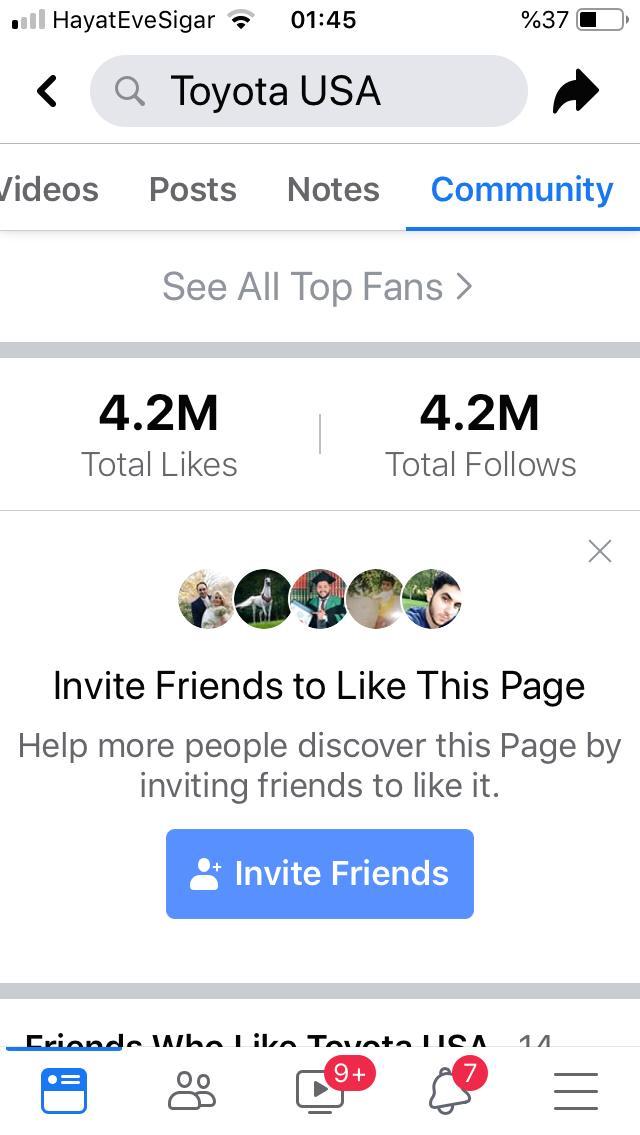
Fugger, 1: Toyota USA on Facebook, www.facebook.com/business/success/toyota
When the company wanted to renew interest in its new brand (Corolla model) and celebrate with a new options safety (Toyota Safety Sense system TSS) In the car [website]. Toyota posted 4 videos on Facebook to explain the complex technology digestedly and understandably for its audience, the target audience represented by men between the ages of 35-65. Toyota used the purchase reach and frequency to reach and to make sure that they saw the entire campaign, it has created a dedicated audience by Facebook pixel, and the Customer Relationship Management System, which contains data for people who Like the New brand “ Toyota Corolla”( CIRCLE, 2011).
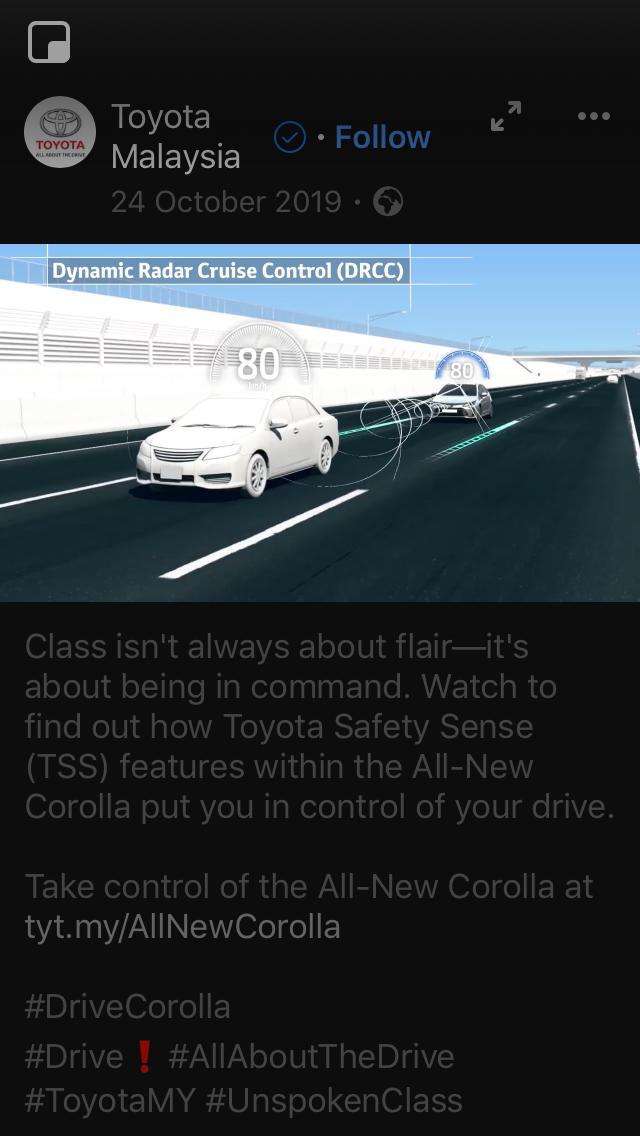
Fugger, 2: Toyota Safety Sense system TSS
Although Toyota targeted a special audience by just focusing on one option, also it was a successful strategy in social media, the results of a study in 2016 showed an increase in ad recall with 33% and an increase in the intention to purchase with 48%.
-
-
- Twitter:
-
Twitter is an application that has a service letting users share information in letters called tweets, the user has fans who will accept tweets posted by the user, users can follow each other. Information can be published on Twitter as tweets, which were sent from users to their followers. Retweeting is determined by the RT @ replaced by the name of the tweet reference in the rewet text (Kwak, 2010).
Toyota USA was made its Twitter page in 2008 and it has more than 797.2K flowers plus more than 34.7k tweets with the new hashtag #letsGoPlaces. After visiting the Toyota USA page on Twitter, we can easily understand that Toyota USA uses a different method to invite the attention of visitors, such as connecting its brand with visitors dream by writing links or texts to touch the emotions of visitors, and it using the same method to show its brand which it is famous with electric motors to save nature, such as taking a photo for its brand with nature.
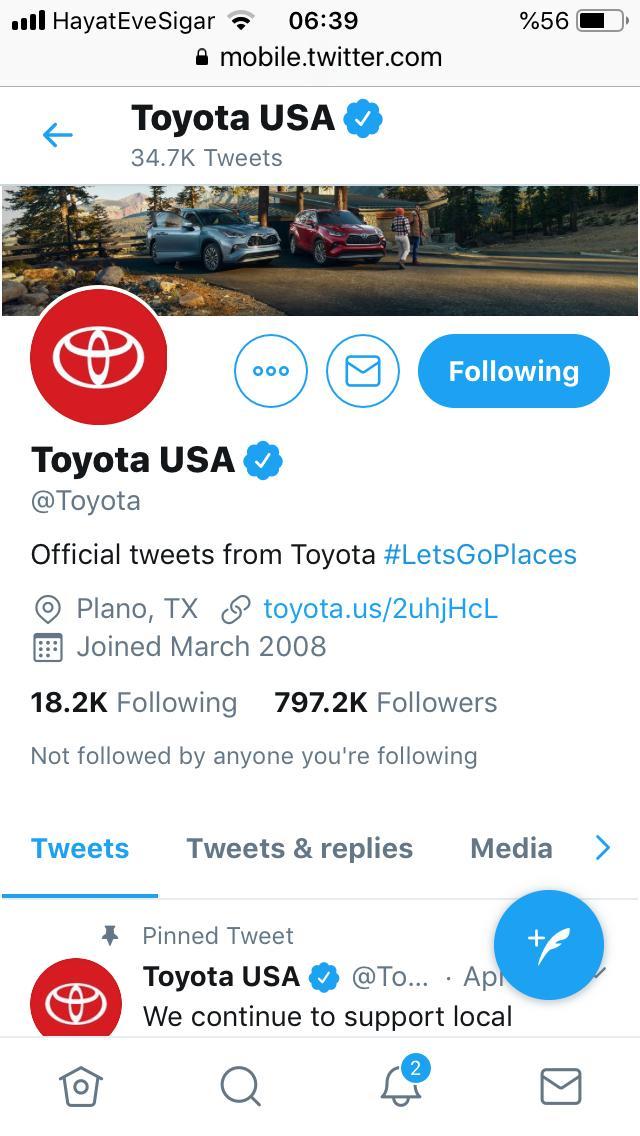
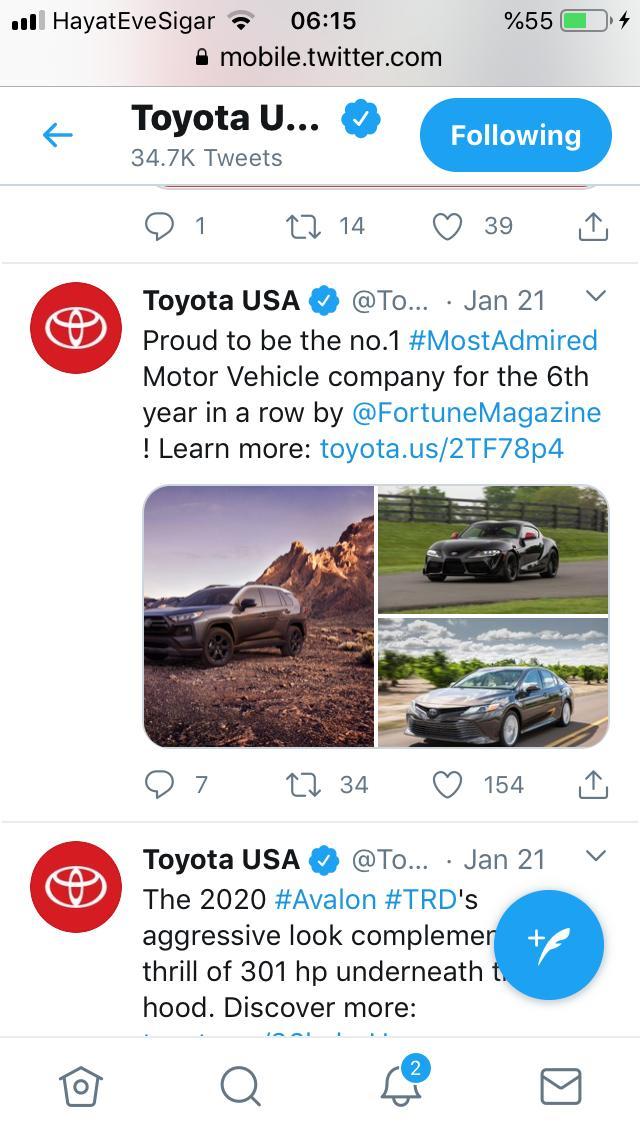
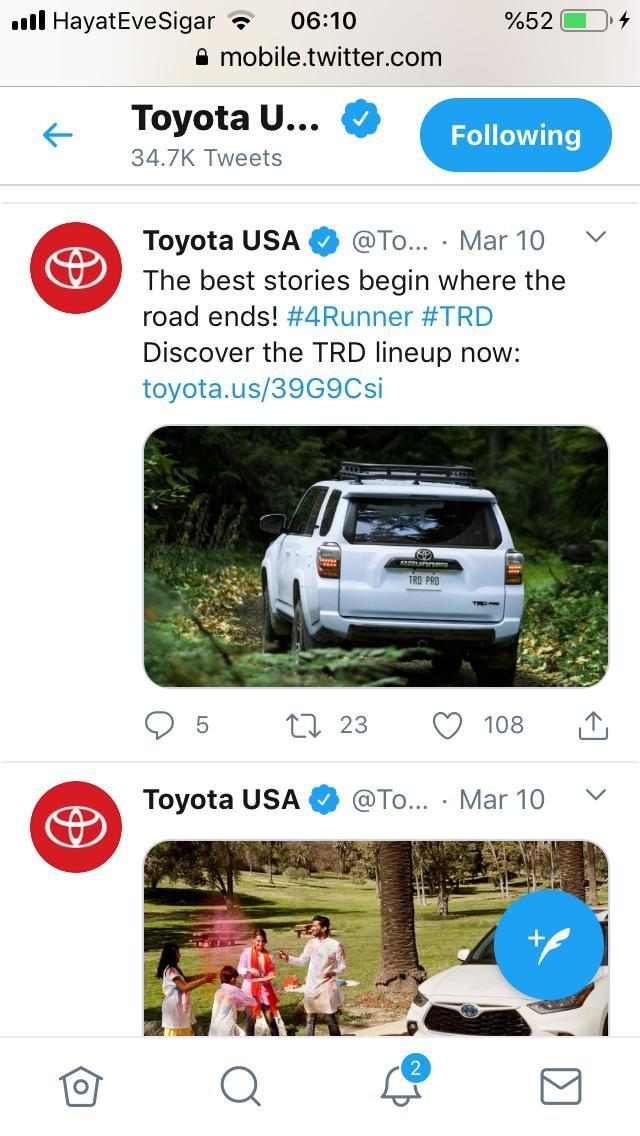
Fugger, 3: Toyota USA Twitter page.
-
-
- YouTube:
-
YouTube was founded in 2005, with its watchword “Broadcast Yourself”. YouTube designed a channel that allows users to download and watch videos created by another user, YouTube has grown by having a mixture of live video clips with official titles until to the latest music videos, and YouTube has become a reference of information for new media plus an important way for branding (Lovink, 2008). Toyota USA was made its YouTube channel in 2008 and it has more than 93,396 views plus more than 394K subscribers.
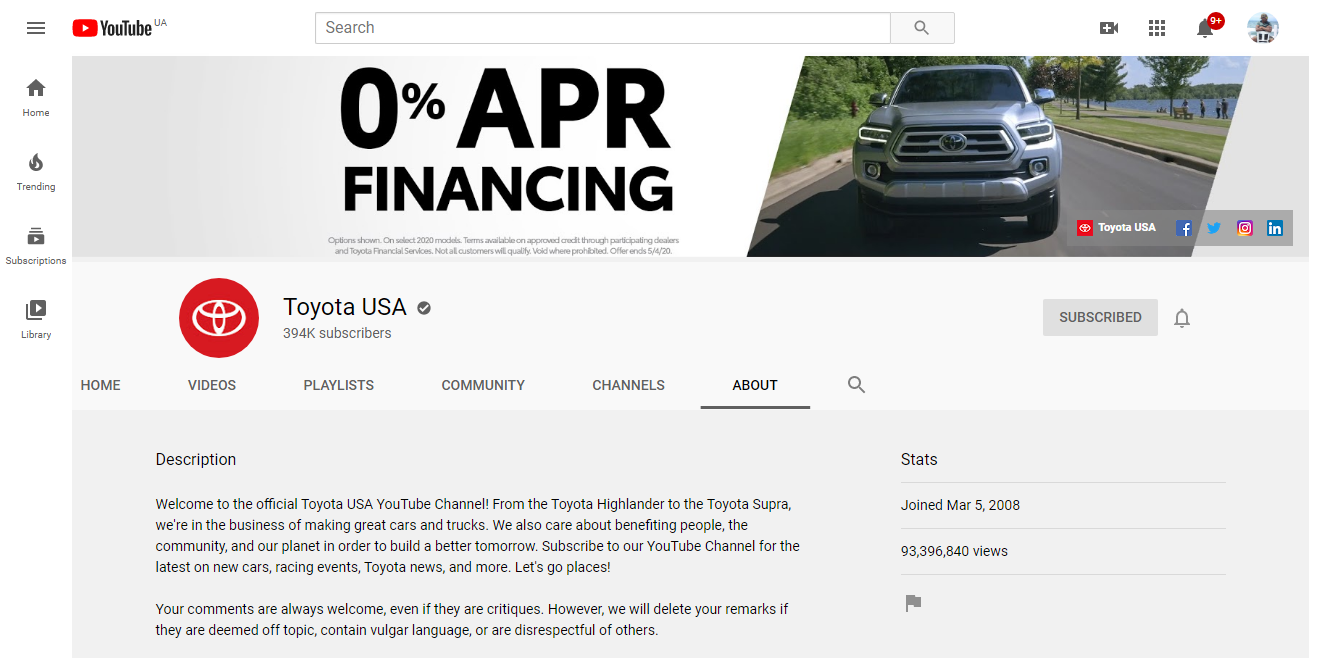
Fugger, 4: Toyota USA YouTube channel
If the brand wants to communicate with people, they should go where people are actively connected. The more brands understand their fans, the better they will be to create content related to their fans. This is what led Toyota to YouTube (Johnson, 2015).
Toyota and YouTube have developed a digital strategy that connects the power of paid media with exclusive content. This strategy lets Toyota find its audience and communicate with them through powerful stories. Like the “Bold New Camry” which has Super Bowl points “My Bold Dad” and “How Great I Am.” Toyota used the advantage of media like Google Preferred and True View to reach the most popular and attractive YouTube content, ensuring that these videos find your target audiences (GOOGLE, 2016).
-
- Digital branding:
Digital Branding is a strategy designed to build brands by adding options from online tools like websites, apps, social media, and video in the brand. Digital branding consists of a mixture of digital marketing and branding online, to improve digital branding, it goals to make a competitive advantage with the brand (Confos, 2016).
-
-
- Toyota digital branding:
-
Watson Ads is an advertising product that uses high digital technology, which is an electronic technology application that simulates reality by making personal conversations between the brand and customers wonderfully and easily, also reveals consumers vision and product effectively. You can find it in the Weather Company app and weather.com.
Toyota is the first brand that uses Watson Ads, use it to answer consumer questions about the new brand, Toyota asked its customers who use the Watson Ads application to ask questions such as, what specialties does Toyota have in its brand or services? [Website2]
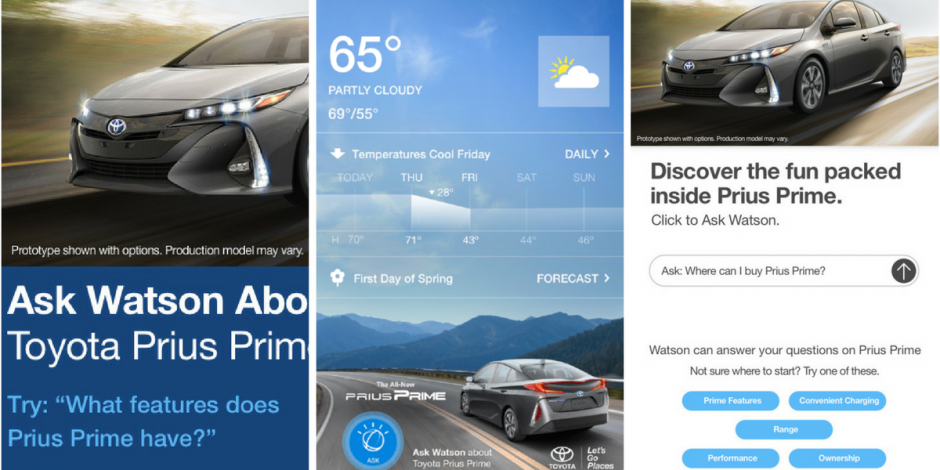
Fugger, 5: Toyota Watson Ads. https://www.thedrum.com/
-
- Online branding:
Online branding is a brand management strategy using the World Wide Web and media channels to put a brand on the market. The more improvement is made on the internet and media channels, the more popular it will be.
-
- Toyota Website:
Toyota website founded in 1995, includes all information about its brand and promotional programs, all illustrations and information are improved in keeping with the latest produced brands, Toyota works very hard to keep its website with this improvement, the website information, such as promotional programs, prices, colors, materials, equipment, specifications and models, and at the same time, some ads, models, equipment and type of services on their websites in subsidiary companies may differ from country to country.
However, the best option and the best service we will find it on the main company website, which holds all the news and information, gives all products and services to the customer or visitors flexibly and understandably with more than 5 languages.
- Brand Resonance Pyramid:
According to brand resonance, consumers have a strong emotional connection to their products, the first and most important stage is to guarantee that customers recognize the brand, build knowledge about the product, and make a connection between the product and its intended use and market group (Keller, 2003).
Establishing a comprehensive meaning for a product is done through Brand Establishment, which allows buyers to begin remembering it. Once a relationship has been established with the customers, the next stage is to find out what they think about the brand which is the responses. The final stage is to use the replies to establish a strong customer relationship with the brand by converting them into actionable insights (Raut, 2015).

Fugger, 6: Brand Resonance Pyramid
-
- Brand Salience:
Toyota staying the first among every car brand in Inter brand, Toyota unveils its brand uniquely and internationally recognizable. The results of a Toyota survey show that 100% of respondents can know the Toyota brand logo and they heard it before.

Fugger, 7: The results of a Toyota survey.
- 23% I have heard of them and have purchased their product.
- 9% I have heard of them and plan to purchase their product.
- 68% I have heard of them but never purchase their product.
- Performance:
Toyota provides high-quality and safe products, as Toyota rated fourth in the United Kingdom in 2014 based on stability and confidence.
| Rank | Make and Model | Reliability Index | Reliability Index |
| 1 | Daihatsu | Very Good | 37 |
| 2 | Honda | Very Good | 41 |
| 3 | Suzuki | Very Good | 48 |
| 4 | Toyota | Good | 67 |
Table, 1: Toyota rated fourth in the United Kingdom in 2014 based on stability and confidence.
According to the user report (2014), Toyota is the number one place among other auto brands where 25% of consumers say Toyota is value for money. People describe Toyota as excellent in performance, value for money, and quality.
-
- Element:
Toyota includes six focus elements that help join and communicate its brands with stability and clarity. They include logos, the Let’s Go Places tagline, the Toyota typography, photography styles, Color palette and design layouts.
Toyota is a 48% family car and a 13% business car. it also has a long historical relationship with the era of family cars where the first Corolla was built in 1966.
Toyota is still a high-quality product, defeating most other car brands. The result of the study shows 47% of people say Toyota is one of the highest quality brands in the world. People have identified the biggest competitors of Toyota such as Honda (83%) and Ford 15%.
Recording to Keeler (2001) in a study that six types of feelings are taken in building a brand. Based on the study conducted, it was obtained that the trademark feeling is represented as safe and preventive.
The study showed that Toyota users have proved that they are ready to buy Toyotas brand again, Toyota, as it is one of the most reliable car brands, Toyota owners are still showing loyalty to the brand, but the study showed that only 16% would advise Toyota to others, and the Popular vehicles such as Audi and BMW are rated much higher (Keller, 2001).
Fugger, 8: Toyota user recommendation.
- Toyota SWOT analysis:
- Toyota is a huge brand, and its great reputation is one of its strengths.
- Its volume helps it invest in research and development to develop its strategy.
- One of the strengths is Toyota’s ability to invite a wide range of customers.
- Toyota has many types of car models that invite different types of customers.
- Toyota has many employees who have difficulty managing and regulating any revisions to conform to the movements of their competitors.
- Its many models make it hard to satisfy all sets of customers at the same time.
- Toyota is famous as a trusted brand, but it doesn’t focus on price or luxury.
- The main opportunity is the global market is increasing with moderate and fuel-efficient cars
- Many countries have grown quickly over the past few years, which increased the request for cars.
- In our time the request for electronic additions to vehicles has increased. Which may create a Competitive advantage
- Increased competitors mean, it will be difficult for Toyota to keep the same market share.
- High raw material costs make an expensive product that leads customers to search for cheaper options outside (Madoh, 2019), (Rayya, 2015).
- Conclusion:
These days, we can say that all the organizations are carrying about online marketing as the savviest way to keep in touch with their customers, which make them create a new strategy to sell their brands, Although, all the customers and people are using the internet as the first step to reach their needs which are making a new strategy of marketing sharing and produced method directed to attract customers who are using the Internet and social media channels.
Also, Toyota online branding strategy is showing that as a great and unique as the reasons for the establishing and succeeding in its brand which led Toyota to set some communication tools like a social media and website. To reaching loyalty branding, equity, extension and trust effectively, Toyota used an incredible way to catch the attention of its clients like adding competitive digitalization as opportunities in its brand continuously. This study can give us the meaning of online branding and how is it can be more suitable to achieve the aim goal to enhance financial situations in a modern lifestyle.
- References:
Almeida, F., Santos, J. D., & Monteiro, J. A. (2020). The challenges and opportunities in the digitalization of companies in a post-COVID-19 World. IEEE Engineering Management Review, 48(3), 97-103.
Tasiyana Kahuni, A. and Rowley, J. (2013), “Corporate brand relationships: the case of TOYOTA F1 Racing Team”, Sport, Business and Management, Vol. 3 No. 1, pp. 8-18. https://doi.org/10.1108/20426781311316870
Teich, S. T., & Faddoul, F. F. (2013). Lean management—the journey from Toyota to healthcare. Rambam Maimonides Medical Journal, 4(2).
Saxonhouse, G., & Wright, G. (2010). National Leadership and Competing Technological Paradigms: The Globalization of Cotton Spinning, 1878–1933. The Journal of Economic History, 70(3), 535-566. doi:10.1017/S0022050710000537
Wada, K. (2004). Kiichiro Toyoda and the birth of the Japanese automobile industry: reconsideration of Toyoda-Platt agreement (No. CIRJE-F-288). CIRJE, Faculty of Economics, University of Tokyo.
Shiomi, H. (1995). The formation of assembler networks in the automobile industry: The case of Toyota Motor Company (1955-80). In INTERNATIONAL CONFERENCE ON BUSINESS HISTORY (Vol. 21, pp. 28-48). UNIVERSITY OF TOKYO PRESS.
Sengupta, S. (2005). Brand positioning: Strategies for competitive advantage. Tata McGraw-Hill Education.
(Buzzell and Gale 1987, Buzzell, et al. 1975) Lazarevich (2012) p. 48.
Farquhar, Peter H., Paul M. Herr, Russell H. Fazio (1989), “Extending trademark rights to new categories”, working paper. Product Research Center, Carnegie Mellon University.
Delgado‐Ballester, E., & Munuera‐Alemán, J. L. (2005). Does brand trust matter to brand equity?. Journal of product & brand management.
Kim, C. K., Lavack, A. M., & Smith, M. (2001). Consumer evaluation of vertical brand extensions and core brands. Journal of Business Research, 52(3), 211-222.
Sharp, B., Rundle-Thiele, S., & Dawes, J. (1997). Three conceptualisations of loyalty (Doctoral dissertation, Department of Marketing, Monash University).
Hjälte, S., & Larsson, S. (2004). Managing customer loyalty in the automobile industry: two case studies.
Knowledge, A. G. Science and Business Administration. Vol 1. no 3. February 2015.
Gul, M. S., Jan, F. A., Baloch, Q. B., Jan, M. F., & Jan, M. F. (2012). Brand image and brand loyalty. Abasyn Journal of Social Sciences, 3(1), 55-74.
Stahl, F., Heitmann, M., Lehmann, D. R., & Neslin, S. A. (2012). The impact of brand equity on customer acquisition, retention, and profit margin. Journal of marketing, 76(4), 44-63.
Delgado‐Ballester, E., & Munuera‐Alemán, J. L. (2005). Does brand trust matter to brand equity?. Journal of product & brand management.
Greto, M., Schotter, A., & Teagarden, M. B. (2010). Toyota: The accelerator crisis. Thunderbird School of Global Management.
Kim, C. K., Lavack, A. M., & Smith, M. (2001). Consumer evaluation of vertical brand extensions and core brands. Journal of Business Research, 52(3), 211-222.
Rajasekera, J. (2013). Challenges to Toyota caused by recall problems, social networks and digitisation. Asian Academy of Management Journal, 18(1), 1.
Special Issue, CIRCLE Conference, University of Dubrovnik, Croatia,27th-29th April 2011.p.474.
Kwak, H., Lee, C., Park, H., & Moon, S. (2010, April). What is Twitter, a social network or a news media?. In Proceedings of the 19th international conference on World wide web (pp. 591-600).
Lovink, G. (2008). The art of watching Databases. Video Vortex Reader–Responses to YouTube, 9-12.
Johnson, Dakota, YouTube Automotive Brand: YouTube Metrics for Success (2015). Masters and Projects 424.
Think with GOOGLE, Case study. Toyota Goes Big and Bold With YouTube and Inspires Its Passionate Communities, April 2016, Video, Consumer Insights, Automotive.
Confos, N., & Davis, T. (2016). Young consumer-brand relationship building potential using digital marketing. European Journal of Marketing.
Madoh, A., Alenazi, J., Alkhamees, L., & Panwar, A. (2019). Case Study on Market Mix Strategies of Toyota Motor Corporation. Asia Pacific Journal of Management and Education (APJME), 2(3), 70-78.
Rayya Mohammad, LIU/Departments/Business_Marketing/Documents. Marketing Policies & Strategies Project ” Toyota”. https://www.academia.edu/30791944
Keller, KL(2001) “Building Customer-Based Brand Equity. (cover story)’, Marketing Management, 10, 2, pp. 14-19, Business Source Complete, EBSCOhost.
Raut, U. R. (2015). Analysis of brand resonance amongst young consumers with reference to select product categories (Doctoral dissertation, Universidade do Porto (Portugal)).
Keller, K. L. (2003). Understanding brands, branding and brand equity. Interactive marketing, 5(1), 7-20.
Websites:
https://www.facebook.com/business/success/toyota-israel
Lisa Lacy, June 15, 2017.The Drum news, Toyota uses cognitive ads from Watson to introduce the Prius Prime. https://www.thedrum.com/
© 1995-2021 TOYOTA MOTOR CORPORATION. All Rights Reserved. https://global.toyota/en/company/profile/
https://global.toyota/en/mobility/toyota-brand/features/emblem/
https://drive.google.com/file/d/1-aGtAroXD8zj2owxjwiz5mEOsrSk8RPe/view
Blog Toyota UK (2010). THe 7 Guiding Principles of Toyota
http://blog.toyota.co.uk/the-7-guiding-principles-of-toyota#.VHzMyTGUcQk [21 November,2014].
BMW. (2014). BMW.com: BMW Design: Design features. [online] Bmw.com.
http://www.bmw.com/com/en/insights/bmw_design/features.html [Accessed 25 Nov. 2014].

